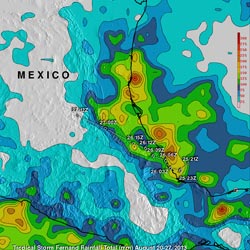NASA Tallies Tropical Storm Fernand's Massive Rainfall from Space

NASA's TRMM Satellite data was used to generate rainfall totals for Fernand from August 20-27, 2013. More than 300mm (~11.8 inches) fell (red) in some areas. Fernand's track is shown overlaid in white. Image Credit: SSAI/NASA, Hal Pierce<br>
Heavy rain with Tropical Storm Fernand generated mudslides. According to the Latin Times, a total of 13 people died as the result of mudslides from Fernand's heavy rainfall. Nine people died in the municipality of Yecuautla, while three people died in Tuxpan and one person in Atzalan.
TRMM precipitation data are used to calibrate rainfall estimates from other satellites. The resulting TRMM-based, near-real time Multi-satellite Precipitation Analysis (TMPA) at NASA's Goddard Space Flight Center in Greenbelt, Md. is used to estimate rainfall over a wide portion of the globe.
The analysis for Fernand's rainfall showed estimated TMPA rainfall totals for the period from August 20-27, 2013 when Fernand was developing and moving through the area. Total rainfall greater than 300mm (~11.8 inches) appeared north of Tampico on Mexico's coastline.
The Latin Times reported damages to structures in 19 municipalities, and breaches of six rivers and streams.
Text credit: Hal Pierce/Rob Gutro
NASA's Goddard Space Flight Center
Media Contact
All latest news from the category: Earth Sciences
Earth Sciences (also referred to as Geosciences), which deals with basic issues surrounding our planet, plays a vital role in the area of energy and raw materials supply.
Earth Sciences comprises subjects such as geology, geography, geological informatics, paleontology, mineralogy, petrography, crystallography, geophysics, geodesy, glaciology, cartography, photogrammetry, meteorology and seismology, early-warning systems, earthquake research and polar research.
Newest articles

A universal framework for spatial biology
SpatialData is a freely accessible tool to unify and integrate data from different omics technologies accounting for spatial information, which can provide holistic insights into health and disease. Biological processes…

How complex biological processes arise
A $20 million grant from the U.S. National Science Foundation (NSF) will support the establishment and operation of the National Synthesis Center for Emergence in the Molecular and Cellular Sciences (NCEMS) at…

Airborne single-photon lidar system achieves high-resolution 3D imaging
Compact, low-power system opens doors for photon-efficient drone and satellite-based environmental monitoring and mapping. Researchers have developed a compact and lightweight single-photon airborne lidar system that can acquire high-resolution 3D…





















